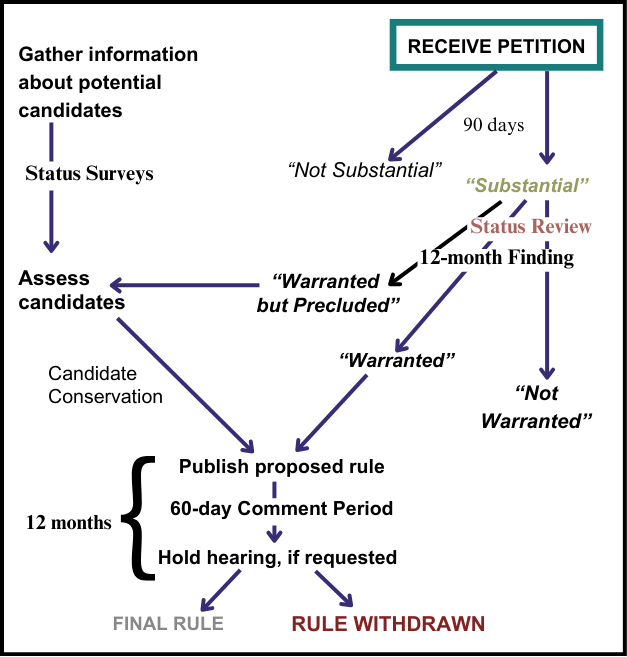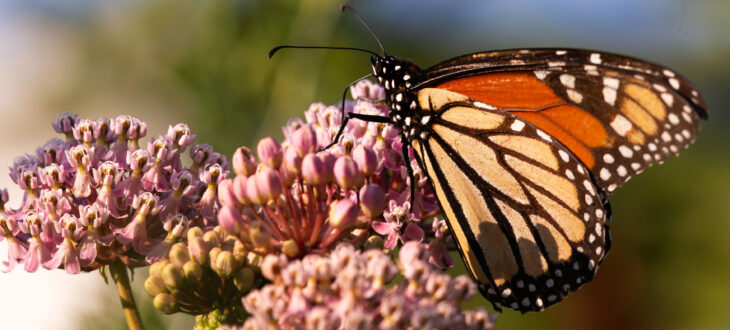Source: Monarch Joint Venture
History of the Monarch Butterfly Listing Process under the Endangered Species Act (ESA)
North America’s eastern and western migratory monarch populations have faced significant threats from habitat loss, pesticide exposure, and climate change, sparking debates and actions around their conservation status. The effort to list the monarch butterfly under the Endangered Species Act (ESA) has been a long and complex process driven by growing concerns over the species’ decline.
It is important to emphasize that any listing decision is based on the careful review of multiple years of data and scientific research and is not made in response to short-term trends or immediate concerns.
Timeline at a Glance
-
2014 – Petition and 90-day finding
-
2015 – 2018 – Species Status Assessment Monarch Conservation Database
-
December 2020 – “Warranted, but precluded”
-
December 2024 – Proposed rule, if still warranted
Timeline in Detail
Early Awareness of Decline
- Monarch butterflies have been studied for decades, but in the late 20th and early 21st centuries, widespread alarm was raised about their declining numbers. Researchers and conservationists began documenting significant declines in monarch populations, showing a steep decline in both overwintering populations and prompting conservationists to sound the alarm about the monarch’s vulnerability.
2014 ESA Petition and 90-day Finding
- The formal push to protect the monarch butterfly under the Endangered Species Act began in August 2014, when the Center for Biological Diversity, the Center for Food Safety, The Xerces Society for Invertebrate Conservation, and a leading monarch researcher, Dr. Lincoln Brower, filed a petition with the U.S. Fish and Wildlife Service (USFWS). This petition requested “that the Service list the monarch as a threatened species with a 4(d) rule, which would allow for protection of the monarch but also still permit activities to continue that promote the conservation of the species, such as scientific research and monitoring, citizen monitoring and tagging, and non-commercial classroom and household rearing of monarchs for educational purposes.”
- In December 2014, the USFWS “found the petition presented substantial scientific or commercial information that indicated listing the monarch may be warranted (79 FR 78775) and initiated a range-wide status review.”
- Read the original petition here.
2015 – 2018: Species Status Assessment and Monarch Conservation Database
- Following the petition and 90-day finding, the USFWS initiated a review process involving a comprehensive assessment of the monarch butterfly’s population trends, threats, and conservation needs. This process took several years as the USFWS sought to gather and analyze data, consult with stakeholders, and assess the scientific basis for listing the species.
- During this time, the monarch butterfly became a symbol of broader conservation efforts, with numerous non-governmental organizations, schools, and communities launching initiatives to support monarch habitat restoration. Public awareness and involvement in monarch conservation soared, with people planting milkweed and nectar plants, reducing pesticide use, and contributing to community science programs to track monarch migration.
2020 Species Status Assessment Published and Ruling Announced “Warranted but Precluded” Decision
- In September 2020, the USFWS published findings in the Monarch (Danaus plexippus) Species Status Assessment Report. In December 2020, the USFWS announced its long-awaited decision regarding the monarch butterfly’s listing status under the ESA; The Service determined listing the monarch as an endangered species was warranted but precluded by higher-priority listing actions for other species in greater immediate danger of extinction.
- This decision categorized the monarch butterfly as a candidate species. The USFWS will review its status each year until they can finalize and publish a notice in the Federal Register, a daily Federal Government publication, to list the monarch under the ESA if still warranted. This listing proposal is anticipated to be submitted by December 2024.
- You can read the December 2020 announcement here.
Proposed rule, December 2024
The USFWS announced a proposed rule to list the monarch butterfly as threatened under the Endangered Species Act, accompanied by a 4(d) rule and critical habitat designation. This proposed rule does not immediately list the monarch under the ESA but marks a significant step in the decision-making process for its protection.
You can read the December 2024 announcement here.
What happens if the USFWS determines a listing for the monarch butterfly is still warranted in December?
If the USFWS determines the monarch butterfly listing is still warranted, it means monarchs meet the criteria for being listed as either “threatened” or “endangered” under the Endangered Species Act (ESA). If the listing is no longer warranted, the process ends.
Next Steps:
-
Publish the proposal and open public comment period– The proposal to list the monarch butterfly, and designate critical habitat, will publish in the Federal Register on December 12, 2024. A 90-day comment period will open on December 12, 2024, and will close on March 12, 2025. Information about how to submit comments can be found on regulations.gov by searching for docket number FWS-R3-ES-2024-0137. This docket also includes information about how to attend two virtual public information meetings, and associated public hearings, about this listing proposal.
- One year to review and finalize the determination– After the public comment period, the USFWS has one year to review the input and scientific data before making a final decision. USFWS could propose changes to the original proposal, list the monarch as “endangered” or “threatened,” or decide not to list the species. If the monarch is listed as threatened, the USFWS will also finalize the 4(d) rule, which could offer exemptions and flexibilities for certain land management practices and land uses. Additionally, the agency may finalize critical habitat determinations if “threatened” or “endangered.”
Final rule– Once the final rule is published in the Federal Register, it typically takes effect within 30-60 days. If the monarch is officially listed, it will be afforded protections under the ESA. These protections typically include prohibitions on harming, harassing, or killing the species, though the finalized 4(d) rule may provide certain exceptions. The listing will also trigger the development of a recovery plan to guide conservation activities.

Ongoing Conservation Efforts
Conservation efforts across North America have steadily advanced, with federal and state agencies, non-profits, landowners, and local communities working together to restore habitats. These collaborations emphasize areas essential for monarchs’ breeding, migration, and overwintering, aiming to boost milkweed planting and encourage pollinator-friendly practices. Various U.S. programs and organizations are also actively promoting monarch conservation through these initiatives.
It’s important to note that under the ESA, funds are shared across all threatened and endangered species, so new funding is not automatically allocated when a species is listed. This emphasizes that the ESA is just one of many essential tools for monarch conservation, underscoring the importance of supporting broader legislation and initiatives dedicated to protecting monarchs and pollinator habitats.
In Oklahoma
The Oklahoma Monarch & Pollinator Collaborative launched the a Statewide Monarch Conservation Plan in 2018 which is a collaborative action plan consisting of 40+ partners statewide. This plan was implemented over a 6 year period and is currently being rewritten. The popular Okies for Monarchs outreach and education campaign was born from this plan.
Additional Links and Resources
ESA and Monarchs
- North American Monarch Protections and Listing Status
-
Petition for Protection of the Monarch Butterfly Under the Endangered Species Act
-
Monarch Butterfly Species Status Assessment Report_September 2020
-
Monarch Butterfly Species Status Assessment (SSA) Report_December 2020
-
Pesticide Supplemental Materials for the Monarch Species Status Assessment Report
-
Information for Planning and Consultation (IPaC) project planning tool
ESA General

